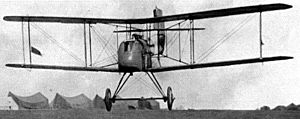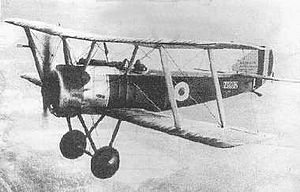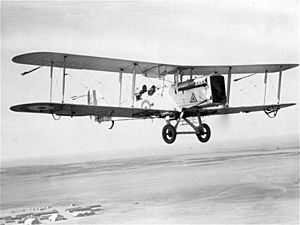John Oliver Andrews facts for kids
Quick facts for kids
John Oliver Andrews
|
|
|---|---|
| Born | 20 July 1896 Waterloo, Lancashire, England |
| Died | 29 May 1989 (aged 92) |
| Allegiance | United Kingdom |
| Service/ |
British Army (1914–18) Royal Air Force (1918–45) |
| Years of service | 1914–45 |
| Rank | Air Vice Marshal |
| Commands held | No. 209 Squadron (1918) No. 220 Squadron (1918) No. 221 Squadron (1918–19) No. 1 Squadron (1920) RAF Mount Batten (1932–34) No. 12 (Fighter) Group (1942–43) No. 13 (Fighter) Group (1941–42) |
| Battles/wars | First World War Russian Civil War Second World War |
| Awards | Companion of the Order of the Bath Distinguished Service Order Military Cross & Bar |
Air Vice Marshal John Oliver Andrews (born July 20, 1896 – died May 29, 1989) was a brave English flying ace during the First World War. A flying ace is a military pilot who shoots down five or more enemy aircraft. He later became a high-ranking officer in the Royal Air Force (RAF).
Andrews was officially credited with shooting down twelve enemy aircraft. He had notable successes against famous German pilots like Stefan Kirmaier, and even faced Max Immelmann and Manfred von Richthofen. He continued his military career through the Second World War, taking on important leadership roles.
Contents
Early Life and Joining the Army
John Oliver Andrews was born in Manchester, England. His father was a brewer. He went to school at Dame Alice Owen's School and Manchester High School.
In 1914, when he was 18, he joined the British Army. He became a second lieutenant in The Royal Scots (Lothian Regiment).
Flying in the First World War
Starting His Air Service: 1914–1915
After serving in the army on the ground, Andrews decided to join the Royal Flying Corps (RFC). This was the air force before it became the Royal Air Force.
He first worked as an observer and gunner in planes. He flew with No. 1 Squadron RFC and later No. 5 Squadron RFC. In October 1915, he learned to fly and became a qualified pilot. He then joined No. 24 Squadron RFC as a pilot, flying the Airco DH.2 fighter plane.
Becoming a Flying Ace: 1916
In April 1916, John Andrews had an exciting encounter. He managed to chase away the famous German ace Max Immelmann, even hitting his plane. A week later, Andrews was promoted to temporary captain and became a Flight Commander.
He scored his first victory on July 21, 1916. He destroyed a German Fokker plane over Allaines. He led his patrol to attack a group of German planes that day.
Andrews continued to score victories. His seventh win, and his last with 24 Squadron, was a big one. On November 22, 1916, he shot down German ace Stefan Kirmaier. The very next day, Andrews was part of a dogfight where the famous German pilot Manfred von Richthofen (the "Red Baron") shot down Andrews' commanding officer. Andrews couldn't help because his plane's engine had been hit by German bullets.
More Victories and Instructor Role: 1917
Andrews didn't score any more victories until he moved to No. 66 Squadron RFC. Here, he flew the Sopwith Pup fighter plane. On April 30, 1917, he shot down his eighth enemy plane. By July 11, he had reached a total of twelve victories. He had destroyed eight enemy planes and forced three others to crash. He also killed Kirmaier and captured his plane.
In July 1917, he was promoted to lieutenant. The next month, he was given a break from combat. He became an instructor at Scampton aerodrome, teaching new pilots.
Returning to the Front: 1918
In March 1918, Andrews returned to the front lines. He became a Flight Commander in No. 70 Squadron RFC. On April 1, 1918, the Royal Air Force was officially formed. On this historic day, Andrews was promoted to Captain.
In May 1918, he became the Officer Commanding of No. 209 Squadron RAF, flying Sopwith Camel planes. Later that year, he took command of No. 220 Squadron RAF. In December 1918, he moved to command No. 221 Squadron RAF. His new task was to fly Airco DH.9 planes in southern Russia.
Between the World Wars
After the First World War, Andrews led 221 Squadron in Russia. They supported the Russian White Army against the Bolsheviks in 1919.
In August 1919, he was given a permanent position as a flight lieutenant in the Royal Air Force. He served in India for a while. Then, he returned to Britain to study at Cambridge University in 1920.
During the years between the two World Wars, Andrews continued his education. He attended London University, the RAF Staff College, and the Imperial Defence College. He also became a top German interpreter. These studies helped him get many different jobs and promotions. He became a squadron leader in 1924 and a wing commander eight years later. In 1937, he was promoted to group captain.
Second World War and Retirement
When the Second World War began on September 1, 1939, Andrews was promoted to air commodore. In early 1940, he became the Director of Armament Development for the RAF. This meant he helped develop new weapons for the air force.
He continued to rise through the ranks. He became an acting air vice marshal in November 1940. In 1941, he was given command of No. 13 (Fighter) Group. In 1942, he took command of No. 12 (Fighter) Group. These groups were very important for defending Britain during the war.
Air Vice Marshal Andrews retired from the RAF on April 17, 1945. He passed away on May 29, 1989, in Windsor and Maidenhead.
Awards and Honours
John Oliver Andrews received several important awards for his bravery and service:
- Military Cross (MC) (awarded October 20, 1916): This award was given for his outstanding courage and skill. He was a great leader of patrols and had shot down four enemy planes. He was known for getting very close to enemy machines to bring them down.
- Bar to Military Cross (awarded December 11, 1916): He received a "Bar" which means he earned the Military Cross a second time. This was for his continued bravery and determination in leading patrols and attacking enemy aircraft. By this time, he had accounted for his ninth enemy plane.
- Distinguished Service Order (DSO) (awarded July 26, 1917): This high award recognized his exceptional bravery and dedication. He led over thirty offensive patrols with great success and took part in more than twenty-two air combats. His skill and courage in destroying enemy aircraft were described as "magnificent."
- RUSI Essay Gold Medalist (1932): He won a gold medal for an essay he wrote for the Royal United Services Institute.
- Companion of The Most Honourable Order of the Bath (CB) (appointed June 11, 1942): This is a very prestigious honour given for excellent service, usually to military officers or civil servants.




